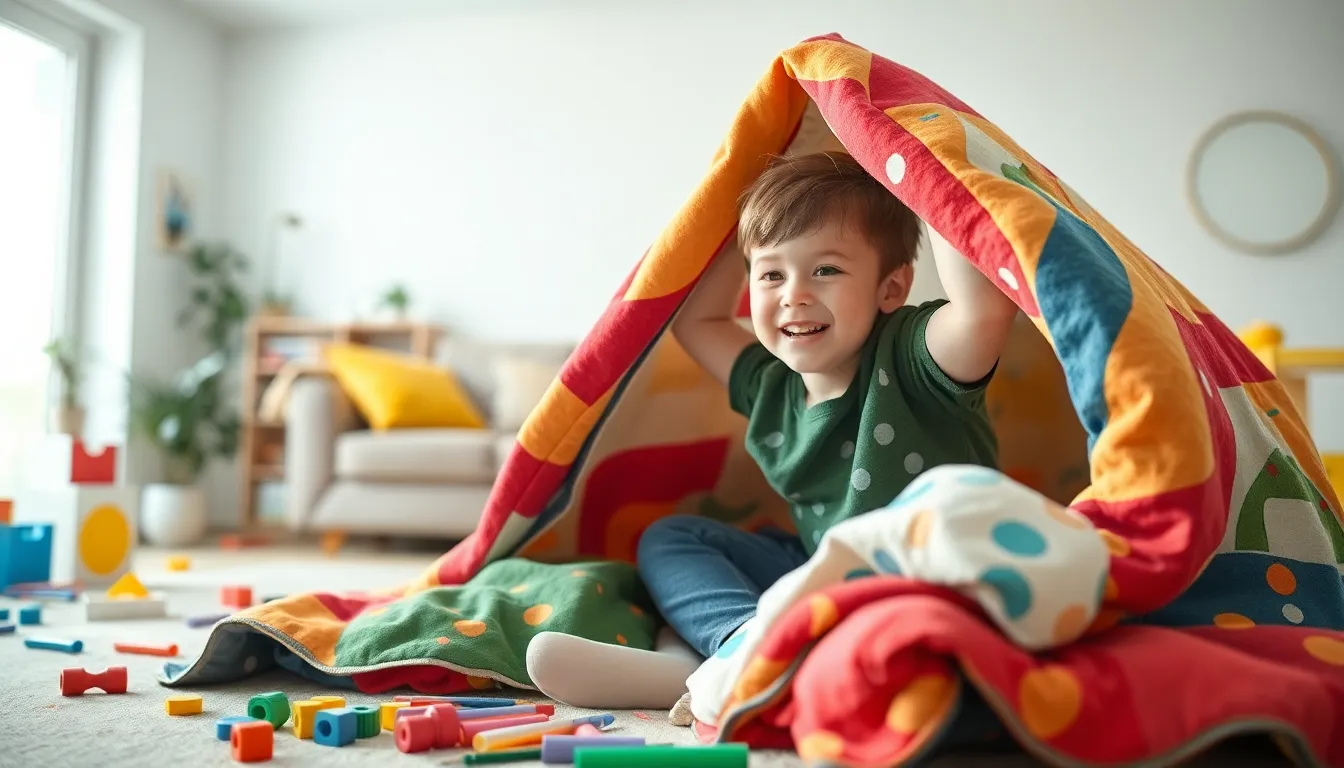Creative play isn’t just child’s play; it’s the secret sauce for unleashing imagination and innovation. Imagine a world where cardboard boxes become spaceships and kitchen utensils transform into musical instruments. That’s the magic of creative play, where the only limit is one’s imagination—well, that and maybe a lack of glitter.
In a society that often prioritizes structure and routine, embracing creative play can feel like a rebellious act. Yet, it’s essential for cognitive development and emotional well-being. Whether it’s through art, role-playing, or simply daydreaming, engaging in creative play fosters problem-solving skills and boosts confidence. So, let’s dive into the whimsical world of creative play and discover how it can spark joy and creativity in both kids and adults alike. After all, who says grown-ups can’t have fun too?
Table of Contents
ToggleUnderstanding Creative Play
Creative play encompasses activities that allow individuals to express themselves freely and inventively. It goes beyond structured tasks, encouraging exploration and imagination.
Definition of Creative Play
Creative play describes a variety of activities that stimulate the imagination. Engaging in arts and crafts, role-playing, or using everyday objects for innovative purposes exemplifies this concept. It encourages spontaneity and open-ended exploration, enabling individuals to create unique scenarios and solutions. Often unstructured, creative play fosters a sense of freedom, allowing the mind to wander and innovate.
Importance of Creative Play in Development
Creative play plays a critical role in cognitive and emotional development. Research indicates that it enhances problem-solving skills and boosts confidence. By participating in imaginative activities, individuals develop adaptability and improve their ability to think independently. Furthermore, creative play can lead to stronger social skills as individuals learn to collaborate with peers during group activities. Overall, it contributes significantly to fostering not just creativity but overall well-being across different age groups.
Types of Creative Play

Creative play encompasses various forms that stimulate imagination and personal expression. Key categories include free play and structured play, each offering unique benefits.
Free Play versus Structured Play
Free play allows individuals to explore creativity without constraints. Children often engage in spontaneous activities, such as building forts or creating imaginary worlds. In contrast, structured play provides specific objectives and guidelines, like following a game’s rules. Both forms contribute to cognitive development, with free play enhancing self-direction and structured play fostering teamwork. Finding a balance between the two can maximize developmental benefits.
Role of Imagination in Creative Play
Imagination serves as the backbone of creative play. It allows individuals to envision possibilities beyond their immediate environment. Pretend scenarios often emerge during activities like role-playing or storytelling. When engaging in creative play, individuals learn to navigate complex concepts, enhance problem-solving skills, and develop emotional intelligence. Utilizing imagination opens doors to innovative thinking and deeper connections in social interactions.
Benefits of Creative Play
Creative play offers numerous advantages, particularly in cognitive and emotional development. Engaging in imaginative activities supports overall well-being across all ages.
Cognitive Development
Creative play enhances critical thinking and problem-solving abilities. Open-ended play encourages individuals to explore various solutions to a single challenge. Imagination fuels innovation, allowing for diverse perspectives and ideas. As individuals manipulate materials or engage in role-playing, they develop spatial awareness and fine motor skills. Research shows that children exposed to creative environments perform better academically. They become more adept at adapting to new situations, which fosters resilience.
Social and Emotional Growth
Creative play plays a crucial role in social interactions and emotional intelligence. Engaging in group activities cultivates collaboration and communication skills. Participants learn how to share ideas and resources, promoting teamwork. Role-playing scenarios help individuals understand different emotions and viewpoints, enhancing empathy. Creative expression also provides a healthy outlet for feelings, allowing for emotional regulation. Studies indicate that children involved in creative play demonstrate higher self-esteem and confidence, supporting healthier relationships and social connections.
Encouraging Creative Play
Encouraging creative play involves fostering environments and activities that stimulate imagination. Both children and adults benefit significantly from engaging in creative pursuits.
Creating an Inspiring Environment
Inspiring environments foster creativity. Utilize open spaces filled with various materials, allowing individuals to experiment without constraints. Incorporate art supplies, building blocks, and natural elements to ignite imagination. Colors and textures can stimulate the senses and inspire new ideas. Remove distractions to create a calm, focused space that encourages exploration. Shelving items where they are easily accessible invites spontaneous play. Additionally, displaying completed projects cultivates pride and motivates continued creative endeavors.
Activities to Promote Creative Play
Diverse activities nurture creative skills effectively. Role-playing games allow individuals to step into different characters, fostering empathy and perspective. Art projects, like painting or sculpting, encourage expression and innovation while refining motor skills. Storytelling sessions inspire narrative thinking and comprehension. Engage in music and movement activities that combine expression and physicality, sparking joy and creativity. Nature exploration offers a chance to connect with surroundings, prompting imaginative play. Incorporating collaborative group activities enhances social interactions and teamwork while promoting shared creative experiences.
Challenges to Creative Play
Creative play faces several challenges that can limit its potential benefits for individuals.
Over-Scheduling and Restrictions
Over-scheduling diminishes opportunities for spontaneous play. Many children juggle various extracurricular activities, leaving little time for unstructured exploration. Restrictions from parents and educators might prevent engaging in certain activities that promote creativity. The pressure to perform in structured environments often stifles imaginative thinking. Instead of encouraging free play, rigid schedules force individuals into predefined roles. Ensuring balance between structured activities and open-ended playtime fosters creativity effectively.
Balancing Screen Time
Screen time poses significant challenges to creative play. Excessive use of digital devices can limit face-to-face interactions and physical exploration. While technology offers educational benefits, it often replaces hands-on experiences that spark creativity. Engaging with screens frequently reduces time spent on imaginative play. Limiting screen time encourages more interactive and imaginative activities. Finding a healthy balance between digital engagement and real-world exploration supports holistic development and nurtures creativity.
Embracing creative play is essential for nurturing imagination and innovation in both children and adults. It serves as a powerful tool for cognitive and emotional development while fostering social skills through collaboration and empathy. By encouraging open-ended exploration and providing inspiring environments, individuals can unlock their creative potential and enhance their overall well-being.
Balancing structured activities with spontaneous play is crucial for sustaining creativity in today’s fast-paced world. Finding this equilibrium allows for the joy of creative play to flourish, leading to enriched experiences and stronger connections with others. Prioritizing creative play not only benefits personal growth but also cultivates a vibrant community where imagination thrives.








